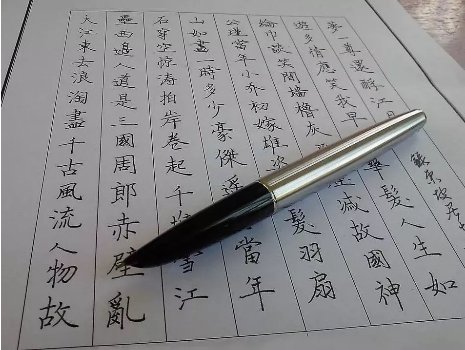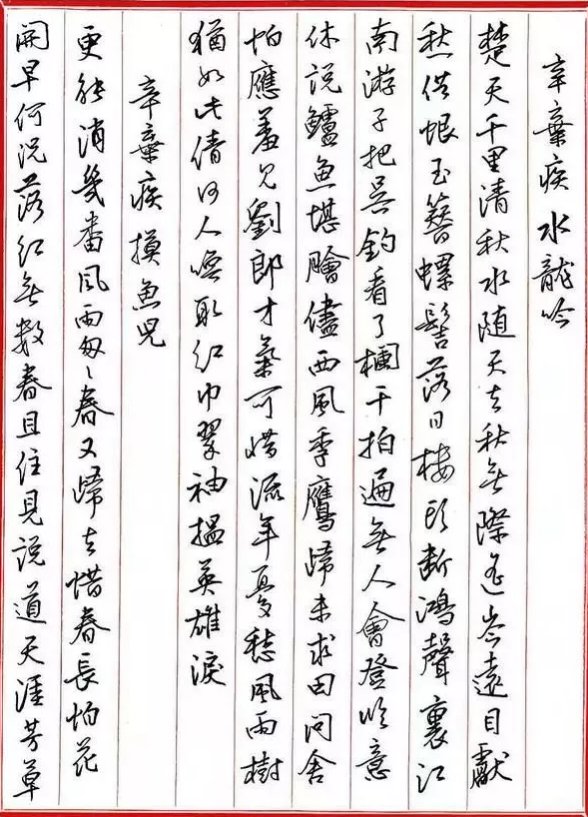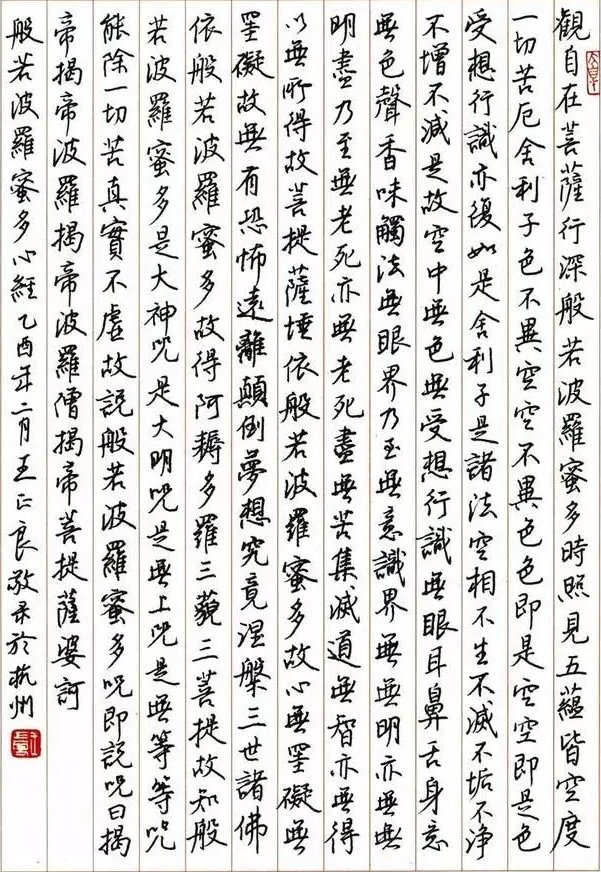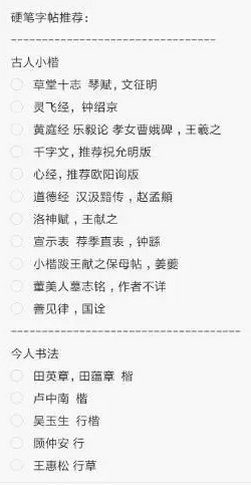First, let’s talk about what a hard pen is. A hard pen refers to all writing pens except brushes. Its writing tools include fountain pens, ballpoint pens, dip pens, pencils, plastic pens, bamboo pens, wooden pens, stylus pens, etc., with ink as the main There are dozens or hundreds of carriers to express Chinese character writing skills. It is easy to carry, fast to write, and widely used.

Hard-pen calligraphy, hard-pen calligraphy and the art of hard-pen calligraphy are the three stages of learning hard-pen calligraphy. Therefore, to appreciate whether a piece of calligraphy is hard-pen calligraphy or the art of hard-pen calligraphy depends on whether it is artistic and beautiful. Of course, sometimes it's hard to tell. There is no clear boundary between hard-pen calligraphy and hard-pen calligraphy art. It depends on the level of the appreciator, which rises to the category of appreciation.
Learning hard-pen calligraphy is no easier than learning soft-pen calligraphy. For beginners, learning hard-pen calligraphy actually requires mastering the correct practice methods, and more emphasis is placed on the writer getting guidance on writing methods. If the training is not targeted and purposeful, blindly posting will usually have little effect. You may not have noticed that many of my friends who write all day long still write in a messy and unorganized way.
This is precisely because they have not mastered writing yet, and they repeat inappropriate writing methods over and over again. In the end, they just solidify the inappropriate methods into their own bad writing habits.

1. Writing tools
To write well, you should first understand the writing tool you are using. Currently, the mainstream hard-tipped calligraphy writing tools on the market are pens and pencils. Secondly, there are gel pens, which became popular due to the popularization of computer marking, and ballpoint pens, which have unsatisfactory writing performance and are dying.
Next, I will simply start with these characteristics and compare the performance and usage differences of several pens.
1.1 Pencil - a useful tool for beginners, with strong expressiveness of stroke thickness
In the process of hard-pen calligraphy writing, the biggest feature of pencil is its strong expressive power. Even if it is the same pencil, the lines written with different pressure will have different shades of color. In other words, in addition to showing changes in thickness of strokes, it can also show changes in shades of color. Therefore, pencil strokes have a stronger sense of layering and can express far richer textures than other similar writing tools. But on the contrary, its shortcomings are also quite obvious.
Because during the writing process, handwriting is formed by graphite adhering to the paper. It cannot eat ink into the paper like a pen. So it fades very easily and is inconvenient to store.
1.2 Ballpoint pen - if it’s not easy to use, you can throw it away
After explaining one of the pens in detail, the characteristics of the other pens will be easier to explain. Most ballpoint pens use oil-based ink, which can not only express changes in the thickness of the strokes, but also express changes in the depth of the color to a certain extent. But the reason why the ink of the ballpoint pen can flow to the paper is because the ink first flows to a small ball inside the pen tip; during the writing process, the ball rotates and brings the ink to the pen tip and paper. The problem caused by this design is that as the time of use increases, the ball will wear to a certain extent, making the written strokes thicker. In addition to the strokes of ballpoint pens becoming thicker and thicker as the number of writing times increases, the color of ballpoint pens is often lighter due to the characteristics of oil-based ink itself.
Because the strokes of a ballpoint pen vary less in weight and depth than those of a pencil, it is also relatively difficult to control. Therefore, the frequency of ballpoint pens appearing in the market has also decreased in recent years.
1.3 Gel pen - cost-effective, easy to obtain, and easy to write with
It seems that unknowingly, gel pens have become a new star in the writing instrument industry in recent years. Generally speaking, gel pens produce ink smoothly and the weight of strokes is easy to control; therefore, they are easy to use and have strong controllability. Relatively speaking, the unsatisfactory point of gel pens is that the strokes cannot reflect the changes in shades, and the thickness changes of the strokes are smaller than those of fountain pens. Due to the limitations of the production process, the expressive ability of gel pen refills generally exceeding 0.5cm becomes weak, and it is impossible to write as desired as there is or is not a stringing effect. This feature also limits the size of the fonts written by the gel pen. The written characters are generally slightly smaller, which is not suitable for expressing the details of single characters. Of course, its biggest advantage is its low price and convenience. For me, I am especially fond of it because it has such a nice nickname as gel pen.
1.4 Fountain pen - the kingly rule, pick a good one and get familiar with it
As the veteran of hard-pen calligraphy writing tools, the fountain pen's status is still unshakable for now. The process of writing itself is a process of constant adjustment between the writer and the writing tools. The pen has a long service life and has natural advantages in the process of running in with the user. Because the pen barrel is mostly made of metal, it feels extremely heavy when used. When the pen is swayed on the paper, it often feels like galloping on the battlefield with a spear and a huge sword. In addition, I personally think that because the open-tip pen is more elastic, its use effect is better than that of the dark-point pen. Moreover, the tip of the dark-point pen is thicker, which will block the writer's sight to a certain extent and make it difficult to write. The matter of purchasing a fountain pen has been well-prepared by previous generations.

What I would like to add is that, in a sense, a fountain pen can be called a lifelong companion of the writer. So if you are a working friend, my suggestion is to try enough fountain pens first to choose the true one. Suit your own type. Then, as long as your purchasing power allows, choose the most expensive one. During the writing process, your fingers should be relaxed and natural, and you must not tighten the pen tightly or forcefully compete with the pen.
The reason is as stated in this answer: How to start practicing brush calligraphy?
When your fingers hold the pen, all they provide for the pen is the pressure on the pen barrel. In the direction perpendicular to the paper, this pressure only affects the maximum static friction force of the fingers on the pen. As for the static friction force of the pen, it is enough as long as the combined forces of the pen's gravity and the elastic force of the paper facing the pen cancel each other out. No matter how hard a person holds the pen, it will not affect the stress on this vertical surface; on the contrary, if the pen is held too hard, the writing will be inflexible and difficult, and the written words will appear stiff and devoid of spirituality.
The way to hold water pens such as gel pens and rollerball pens is basically the same as holding pencils. However, because the gel pen transports ink to the paper through liquid capillary action, it is easier to write strokes, so the pen can be held lighter. The second point mentioned in the picture, that the index finger should be bent in two sections and not in three sections, can be ignored. The way you hold a pen is different from the way you hold a pencil.
The difference is that when a pencil gel pen is writing, the effective force on the paper is perpendicular to the paper; while a pen presses the steel piece of the pen tip to deform the pen tip and ink is injected from between the steel pieces. onto paper. Therefore, during the pen writing process, the effective force should be the force that deforms the steel sheet, not the force perpendicular to the paper surface.
Therefore, the key points for writing a fountain pen are:
The penholder should rest against the tiger’s mouth;
Instead of leaning on the metacarpophalangeal joint of the index finger like when holding the pencil before.
The angle between the pen and paper is about 40-65 degrees.
So what should you pay attention to when you first start practicing calligraphy?
The important point is that you have to have a correct attitude. There is no quick success in practicing calligraphy, and people who are eager for quick success and instant benefits have failed.
So how to start practicing calligraphy with zero foundation?
Buy a handy pen, a rice-character practice book, and pick a copybook you like.
Although people who are good at calligraphy do not choose pens, newcomers should choose a pen that is convenient for them, otherwise they will be asking for trouble; whether it is a fountain pen, a gel pen, or a pencil; believe me, a good pen will make you love it. As written above, I will not give you any clues here. I will specifically write about the issue of choosing fountain pens in the future. Buy a notebook with a rice-shaped grid or a field-shaped grid. When you start practicing calligraphy, you must write honestly in the grid. The great masters also came here like this. I bought one of each calligraphy practice book in a stationery store and found the best One that suits you.
The choice of copybook, because we are not calligraphy majors, is not that particular. Whether it is ancient calligraphy or contemporary calligraphers’ copybooks, they are all good models. It is recommended that ancient calligraphy brush and small regular script calligraphy be preferred.
So how to post?
First of all, it is not recommended to copy on transparent paper. Facts have proved that the effect is very little. My method is to put the words on the copybook in a rice grid (some books come with grids, and some mobile phone calligraphy apps also come with grids), and then imitate the words on the copybook in your own calligraphy practice book, and try your best to Until the position and size of each stroke are consistent, practice each character hundreds of times (experts do it thousands of times), then change the next character (even if the writing does not look like it), wait until you finish writing a copybook, and then Continue from the beginning, and so on, until you can write each character very closely without looking at the copybook, which is considered a success.
Also note that practice more is not as good as practice. Don’t rush to practice all the words at once. If A and B practice calligraphy at the same time, A's ability to write 100 characters will be much better than B's ability to master 1,000 words. Even if A has 900 words that he has not mastered, his writing will still be better than B's.
About the choice of fountain pen and copybook
For a long time, hard-pen calligraphy did not receive enough attention. Copybooks with dull structure, boring fonts and no aesthetic feeling can also become popular. It is not a good idea for novices to rush into bookstores and pick copybooks without understanding the aesthetic appeal of calligraphy. It is true that there are masters worthy of respect in the hard-pen calligraphy world. But in fact, even now, compared to traditional brush calligraphy, there are very few people in the calligraphy circle who pay attention to hard-pen calligraphy.
In the past 20 years, the manufacturing technology of gel pens has developed rapidly, but in China, there has been almost no breakthrough in the more anticipated fountain pen manufacturing technology. This regrettable fact also illustrates the contempt for hard-tipped calligraphy in the industry.
At the same time, there has been no breakthrough in pen production technology, which also makes traditional calligraphers believe that hard pens do not have enough expressive power to help calligraphers realize their artistic pursuits. Therefore, no more calligraphers are willing to invest in the field of hard-pen calligraphy for more in-depth research.
But in sharp contrast, because hard-pen calligraphy is far more practical than brush calligraphy, among calligraphy learners, there are more hard-pen calligraphy learners, and they are also more interested in hard-pen calligraphy than brush calligraphy.
The result of this phenomenon is that there are too many fake and shoddy hard-pen calligraphy copybooks on the market. Beginners have to choose the materials that suit them among these many low-quality products, which is like trying to find gold in the sand.
Therefore, I do not recommend here that beginners directly choose hard-tipped calligraphy copybooks for introductory practice; rather, I recommend that they use ancient calligraphers that have been tested by calligraphers for many generations over a long period of time and practice ancient calligraphy directly. If you are interested in practicing regular script, you can consider copying the "Lingfei Sutra", which is Zhong Shaojing's "Liujia Lingfei Sutra". If you are interested in practicing running script, for beginners, it is more recommended to use running script with clear strokes and strict rules. So in terms of running script, my recommendation is "Wen Fu" by Lu Jianzhi. The last sentence is, don’t always rely on teachers and tutorials. The important thing is to practice more and you will succeed if you persist.
Attached is a recommended list of classic copybooks:









